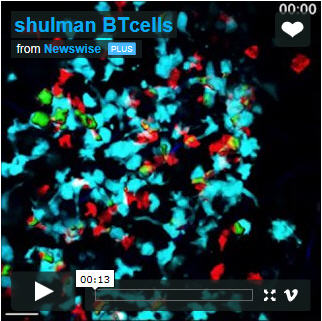Imaging Studies Open a Window on How Effective Antibodies Are Formed

shulman BTcells from Newswise on Vimeo. Connecting. A time-lapse movie shows T cells (red) and B cells (blue) making contact (green) within a mouse germinal center. Interaction between the two types of cells drives the process of diversification, in which B cells are selected based on the effectiveness of the antibodies they produce.
Their surprising finding: T cells and B cells form numerous short-term contacts, each lasting no more than a few minutes, in a dynamic process that is very different from how T cells interact with other cell types. The results were recently published in Science.
The action takes place in so-called germinal centers, tiny structures within the body’s lymphatic system where B cells learn to make antibodies against specific microbes. Within these sites B cells undergo a process known as diversification in which they experience rapid mutations in the genes that encode antibodies. Only the best B cells — those with the highest “affinities” — are selected to leave the germinal centers and become antibody-secreting cells.
“In the germinal centers, T cells discern between B cells that are making effective antibodies and those that are not — it is because of their scrutiny that the immune system learns to take the correct action to fight off infection,” says study author Ziv Shulman, a postdoc in Michel C. Nussenzweig’s Laboratory of Molecular Immunology. “But nobody had ever observed directly and described the dynamics of this process and little is known about how T cells make their determination.”
Nussenzweig, who is Zanvil A. Cohn and Ralph M. Steinman Professor, along with Shulman, and their colleagues, developed a system in which they could observe the germinal centers directly in live mice under physiological conditions, tagging T cells and B cells with separate fluorescent proteins that allowed them to track the movements of the cells in real time. They also developed an algorithm that could process the resulting videos and keep precise track of the quantity of contacts between the two cell types as well as the duration of each contact.
They found that the amount of antigen being picked up by B cells with high affinity antibodies and presented to T cells dictates the duration of interaction between the cells. In these contacts, the B cells are instructed either to differentiate into antibody secreting cells or to undergo further mutation.
To test whether the cells were indeed communicating with one another, the researchers also visualized the amount of free calcium within the cells. They found an increase in intracellular calcium, an indicator of signaling events triggered during the T and B cells interactions. Furthermore, the dynamics of the calcium signaling they observed suggests that not only are T cells telling B cells what to do, but that the flow of information is bi-directional: T cells are also learning from B cells.
“The transient interactional dynamics allow T cells to continuously seek and find B cells that are presenting high levels of antigen and provide them with preferential help, while still permitting competing B cells to mutate and develop,” Shulman says. “It’s an interactive process, with B cells being directed by T cells and T cells learning from their interactions with B cells.”
The research team says that a better understanding of the processes that take place in germinal centers could lead to new ways to manipulate them in order to more effectively harness the body’s immune system to develop vaccines and fight a variety of diseases.
Contact Information
Zach Veilleux
newswire@rockefeller.edu
212-327-8982
Media Contact
All latest news from the category: Life Sciences and Chemistry
Articles and reports from the Life Sciences and chemistry area deal with applied and basic research into modern biology, chemistry and human medicine.
Valuable information can be found on a range of life sciences fields including bacteriology, biochemistry, bionics, bioinformatics, biophysics, biotechnology, genetics, geobotany, human biology, marine biology, microbiology, molecular biology, cellular biology, zoology, bioinorganic chemistry, microchemistry and environmental chemistry.
Newest articles

A universal framework for spatial biology
SpatialData is a freely accessible tool to unify and integrate data from different omics technologies accounting for spatial information, which can provide holistic insights into health and disease. Biological processes…

How complex biological processes arise
A $20 million grant from the U.S. National Science Foundation (NSF) will support the establishment and operation of the National Synthesis Center for Emergence in the Molecular and Cellular Sciences (NCEMS) at…

Airborne single-photon lidar system achieves high-resolution 3D imaging
Compact, low-power system opens doors for photon-efficient drone and satellite-based environmental monitoring and mapping. Researchers have developed a compact and lightweight single-photon airborne lidar system that can acquire high-resolution 3D…





















